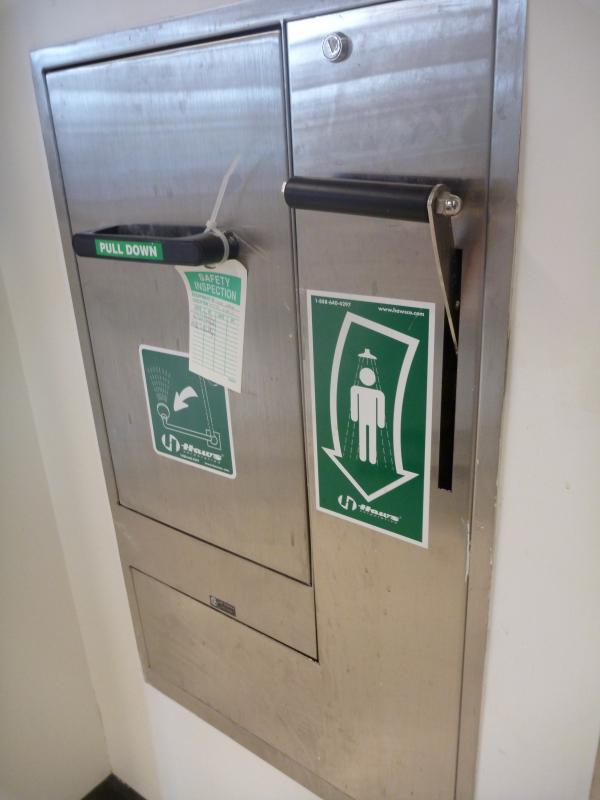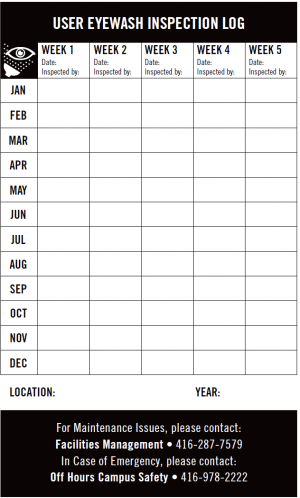
Why are eyewash stations and emergency showers important?
Accidental exposures can still occur even with good engineering controls and safety precautions. As a result, it is essential to look beyond the use of goggles, face shields, and procedures for using personal protective equipment. Emergency showers and eyewash stations are an essential backup to minimize the effects of accidental exposure to biological or chemical substances.
What are the legal requirements?
The University of Toronto is required to comply with sections 124 and 125 of Ontario Regulation 851 - Industrial Establishments (the Regulation), made under the Occupational Health and Safety Act.
According to section 124 of the Regulation:
Where a worker is exposed to a potential hazard of injury to the eye due to contact with a biological or chemical substance, an eyewash fountain shall be provided.
According to section 125 of the Regulation:
Where a worker is exposed to a potential hazard of injury to the skin due to contact with a substance, a quick-acting deluge shower shall be provided.
When am I required to have an eyewash station or emergency shower?
An eyewash station must be provided where a worker is exposed to any potential hazard or injury to the eye due to contact with a biological or chemical substance. If there is a potential for a worker to suffer a chemical splash to the skin, a safety shower must be provided in the laboratory for immediate and thorough drenching of the entire body.
At a minimum, a functional eyewash station should be present in almost every laboratory space, with very few exceptions. Eyewash stations are also present in some Facilities areas. There may be rare instances where biological or chemical usage is so limited that an eyewash is not specified by a risk assessment. To this end, the Eyewash and Shower Needs Assessment Flowchart can be used as part of the risk assessment or in consultation with EHS.
Who is responsible for testing eyewash stations and safety showers?
For individual laboratory spaces, the Laboratory Supervisor (e.g. Principal Investigator or Lab Manager) is responsible for ensuring that eyewash stations within the space are tested regularly by laboratory personnel. In shared lab spaces or Facilities areas, the Supervisors / Departments should agree on a testing schedule and the personnel to perform the testing.
Safety showers across the campus (in addition to all eyewash stations) are inspected and certified annually by the Facilities Management Department (FMD).
DO NOT ATTEMPT TO TEST SAFETY SHOWERS YOURSELF!
(Only FMD has the proper equipment to do so.)
How often do I need to test eyewash stations?
Eyewash stations should be bump tested once a week to check for proper operation. It should be tested for the length of time it takes to flush the lines of stagnant water, which can range from 10 seconds to 3 minutes depending on the eyewash station. This will help prevent the growth of microorganisms and build-up of rust and mineral deposits in the lines.
Malfunctioning eyewash stations should be reported immediately to Facilities Management at 416-287-7579.
End users should record their weekly checks on an inspection tag or sheet that is posted by the eyewash station. Inspection tags (3.5" x 6", pictured below) are available from the EHS office upon request.

Can I use portable eyewash units instead of plumbed units?
Portable eyewash units, such as eyewash bottles or self-contained pressurized units, are only to be used in situations where no plumbed eyewash is available or as an interim measure until a plumbed eyewash unit can be installed. Portable eyewash units should not be used as the primary eyewash unless approved by EHS.
Where can I find more information?
The University of Toronto's Safety Eyewash and Shower Standard describes in more detail the design, accessibility, operational and testing requirements for eyewash stations and safety showers. This standard is based on the American National Standards Institute's (ANSI) Standard for Emergency Eyewash and Shower Equipment (ANSI Z358.1).